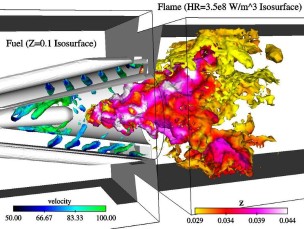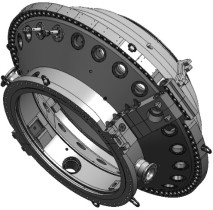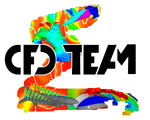Simulation tools used in INTECOCIS:
In INTECOCIS, multiple massively parallel simulation tools will be used. The two main codes are:
- AVBP (a Large Edddy Simulation code developed by CERFACS and IFP Energies Nouvelles) and
- AVSP (a Helmholtz solver required to compute acoustic eigenmodes of any combustion chamber). Both codes are developed and maintained for INTECOCIS by the CERFACS CFD team.
More information on these codes can be obtained on the CFD web site of CERFACS.
Large Eddy Simulation tool: AVBP
The AVBP solver (1,2,3) solves the compressible Navier-Stokes equations for a multicomponent mixture of fluids on unstructured and hybrid meshes. DNS and LES of turbulent flows requires low-dissipation schemes and centered schemes are generally good candidates. The numerical integration of AVBP is based on a centered scheme and uses a Taylor-Galerkin weighted residual central distribution scheme, called TTG4A for time integration. This scheme is third-order in space and fourth-order in time (4).


Before 2005, high-fidelity CFD was possible only in DNS and cubic boxes. AVBP (and today a few other solvers) have brought high-fidelity schemes solvers adapted to real geometries using hybrid meshes. This has allowed the community to move from high-fidelity simulations in cubes to high-fidelity simulations in real engines. The only limit today to this revolution is the machines capacity.
AVBP is developed jointly by CERFACS and IFP Energies Nouvelles and distributed to multiple laboratories and companies.
References:
(1) Moureau, V., Lartigue, G., Sommerer, Y., Angelberger, C., Colin, O. and Poinsot, T. “High-order methods for DNS and LES of compressible multi-component reacting flows on fixed and moving grids”, J. Comp. Phys. 202, 710-736 (2005).
(2) Schmitt, P., Schuermans, B., Geigle, K. P. and Poinsot, T. “Large-eddy simulation and experimental study of heat transfer, nitric oxide emissions and combustion instability in a swirled turbulent high pressure burner”, J. Fluid Mech. 570, 17-46 (2007).
(3) Gourdain, N., Gicquel, L., Montagnac, M., Vermorel, O., Gazaix, M., Staffelbach, G., Garcia, M. Boussuge, J-F. and T. Poinsot, “High performance parallel computing of flows in complex geometries - part 1: methods”, Comput. Sci. Disc. 2 015003 (26 pp), 2009.
(4) Colin O. and Rudgyard M.. Development of high-order taylor-galerkin schemes for un- steady calculations. J. Comput. Phys., 162(2):338–371, 2000.
Helmholtz solver: AVSP
Although LES with AVBP is very efficient, it is also expensive and this brute force method needs to be complemented by a purely acoustic solver which can compute all unstable modes of a combustor, using a few simplifications. This is what the AVSP solver does. The following image displays an AVSP computation of a large industrial gas turbine: six modes can appear and their structures are displayed on the right side of the image.


A major asset of acoustic solvers is to isolate the elements leading to combustion instabilities into different blocks (something a brute force LES cannot do): a) the acoustics of the combustor, b) the outlets and inlets impedances and c) the response of the flame which is quantified by a function called the Flame Transfer Function (FTF) describing how much unsteady heat release is produced by a flame when it is submitted to an acoustic velocity fluctuation. TA codes can operate in the frequency domain or in the time domain but in all cases, TA codes are faster than brute force LES and their information more useful to suppress instabilities. Together, (2), LES codes (such as AVBP) and acoustic solvers (such as AVSP) will constitute the basic tools of INTECOCIS.
AVSP is developed by CERFACS and Université of Montpellier (Pr F. Nicoud) with the support of SAFRAN.
References:
(1) F. Nicoud, L. Benoit, C. Sensiau, and T. Poinsot. Acoustic modes in combustors with complex impedances and multidimensional active flames. AIAA Journal, 45:426-441, 2007.
(2) Selle, L., Benoit, L., Poinsot, T and Krebs, W. “Joint use of compressible LES and Helmholtz solvers for analysis of rotating modes in an industrial swirled burner”, Comb. Flame 145 (1-2), 194-205 (2006)


